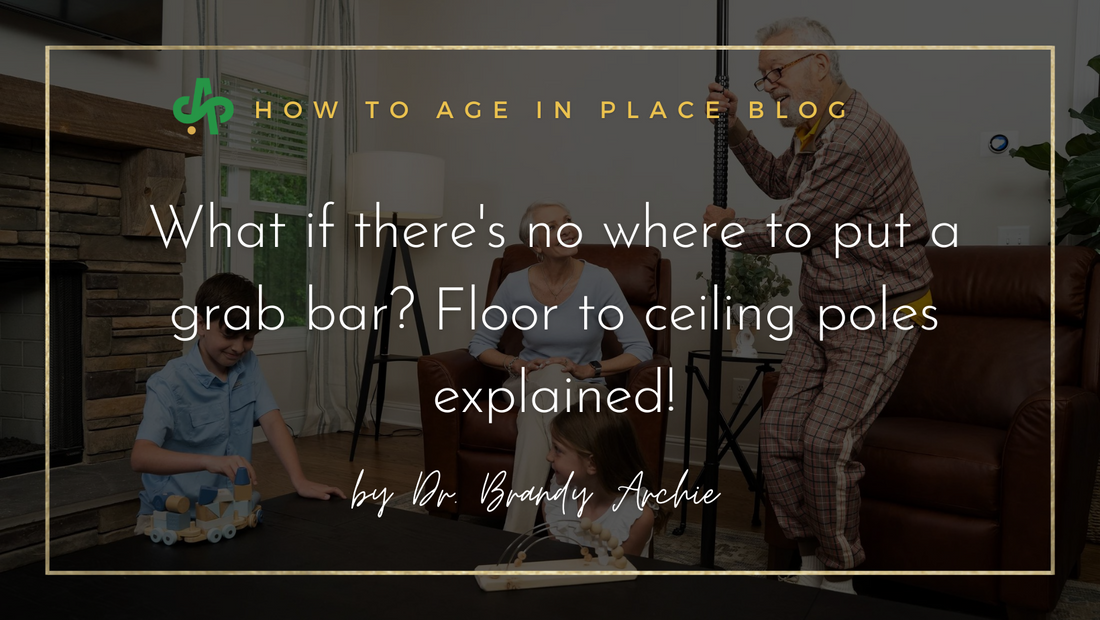Stability and Independence: Unleashing the Power of Floor-to-Ceiling Poles for Transfers
So we're back today to explore an alternative to grab bars that also promotes stability and independence during transfers: the floor-to-ceiling pole. In this article, we'll discuss the importance of stability during transfers, when a floor-to-ceiling pole may be clinically appropriate, why it may be a preferred option over a grab bar in certain environments, and the installation process. Let's dive in!
The Importance of Stability in Transfers
Stability during transfers is crucial for minimizing the risk of falls and promoting independence. When individuals have a secure point of support, they can confidently move from one surface to another, such as from a bed to a wheelchair or from a wheelchair to a shower seat. This stability empowers individuals to maintain their balance, reducing the chance of accidents and enhancing their overall safety.
It's so much safer to move your body under your own power - even when assisted by something like a grab bar or arm of a chair - than it is to have a person give you a hand to get up from sitting. But unfortunately there is not always an arm on a chair or a wall that a grab bar to attach to.
Clinical Reason for Floor-to-Ceiling Poles for Transfers
Floor-to-ceiling poles, like the Titan Floor to Ceiling Stability Pole or the Stander Floor to Ceiling Pole may be clinically appropriate in those situations where a sturdy handhold is needed but there aren't any other options because it's open space. Here are a few examples:
- Individuals with mobility limitations: Floor-to-ceiling poles can benefit individuals with conditions such as arthritis, stroke, or spinal cord injuries, who may have difficulty with balance or strength during transfers.
-
Assisted living or Independent living apartments: These floor-to-ceiling transfer poles can play a vital role in facilitating safe and effective transfers during the recovery process after surgery or injury, supporting individuals as they regain their independence without causing damage to the walls or ceiling of the rented space.

- Aging population: Floor-to-ceiling poles are particularly valuable for older adults who may experience decreased strength, balance issues, or fear of falls, enabling them to maintain their autonomy in daily activities especially in their own home.
Environmental Advantages of Floor-to-Ceiling Poles over Grab Bars
In certain environments, floor-to-ceiling poles offer unique advantages over traditional grab bars:
-
Versatility: Unlike grab bars, which require installation into wall studs, floor-to-ceiling poles don't rely on wall structure. This versatility allows for greater flexibility in choosing the optimal location for support, regardless of wall positioning.
-
Temporary installations: Floor-to-ceiling poles can be installed without permanent modifications to the environment. This makes them suitable for individuals who may require temporary support during a rehabilitation period or while staying in different locations.

- Wide range of adjustable heights: Floor-to-ceiling poles typically offer a variety of height adjustments accommodating ceilings from 7 - 10 feet high. This long vertical stability also allows it to be used for people of different height and coming from different levels - including when trying to get up from the floor.
How to Install Floor-to-Ceiling Poles
Floor-to-ceiling poles can be installed by anyone who can handle a screwdriver and handle about 10 pounds of weight. Often a ladder isn't even needed!
-
Select the appropriate location: Choose a position where the pole can provide optimal support during transfers. It helps to have the person actually do the transfer and see where it would be great to have that extra support. If you'd like an expert eye on the scene schedule a virtual assessment with one of our occupational therapists and we can help make sure the right location is chosen.
-
Assemble the pole: Follow the manufacturer's instructions to put it together. Most come in 2-4 pieces with the hardware needed to quickly and easily put it together.
-
Secure the pole: Follow the manufacturer's instructions to securely attach the pole between the floor and ceiling. It's important to ensure proper tension and stability.
- Confirm stability and safety: Verify that the installed pole is stable and can support the weight and movements involved in transfers. Do this by actually pulling on it and trying to use it the way it's intended. Regularly check the pole's integrity to ensure ongoing safety because if it is held by tension, it could loosen slightly over time.
If you'd like to learn what might be the right stability solution for your situation just take our quiz! Choose Mobility and start answering the questions. It's a quick and easy way to get clinically based insights on what to do next!


